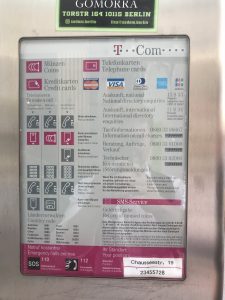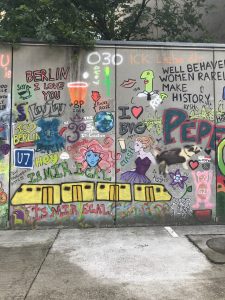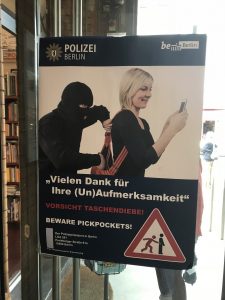The public use of language, especially outside of the continental US, is a very interesting subject. I have been spending my summer working in Berlin, but this past weekend I visited Brussels with my girlfriend. Being the seat of the European Union, there were some very interesting examples of varied language usage. While I was not allowed to take pictures inside the galleries of the Royal Art Museums in Brussels, I noted that the majority of important signs were listed in four languages: French, German, English, and Flemish; and that the museum maps and flyers were available in almost any EU language. While this is certainly an excellent example of multiculturalism, it is clear to anyone that it is more of a necessary business move, designed to accommodate as many tourists as possible.

The more interesting usage of language was what I saw in Berlin, and this is what I took pictures of. I found this to be somewhat of a parallel with the examples from the reading involving Chinatown (Leeman 354). Multiple cultures are intertwining, but the presence of a non-native language is symbolic as well as practical. The graffiti, advertisements, and public advisories in Berlin are almost always in both German and English. While not wholly different from the business centric motivations from the museums in Brussels, especially when looking at the telephone card advertisement, The universality of both English and German existing side by side shows how despite Berlin being the capital of Germany – a country with a storied and varied history as well as a distinct culture, the city itself is home to people of almost every background, and draws not just tourists but full time residents from every corner of the globe. This is where the differences between the employment of language in Berlin and Chinatown differ. While signage and other literature in your stereotypical US Chinatown is still largely directed towards English speakers and Americans, the usage of English in Berlin is used to draw not just people from English speaking nations together, but other expats as well. I think this is best represented by the graffiti, which is actually located right outside the international dorms I have been living in. while definitely influenced by its proximity to a lot of Americans, the progressive social message of much of the graffiti is the same, despite using both English and German to carry said message.

Another aspect brought forward by the reading was the idea of state policies mandating the use of a minority language (Leeman 358). While this might often be seen in the states through the use of both Spanish and English in certain areas, it can clearly be seen in Berlin with English and German instead. The sign pictured is found at the entrance to a local Markthalle, where local food stands and farmers from outside of the city come to sell their goods. It is a popular place among locals and visitors and can get very busy in the middle of the day. Pickpockets are relatively uncommon in Berlin, but as in any urban area are always a risk. Most of the sign is in German, especially the main part which translates to “Many thanks for your (un)attention!” This is somewhat humorous, and gets the point across very well, but would be lost on someone who doesn’t speak German. For the non-German speaker the message of the sign is still clear – look out for your personal belongings in crowded areas. While there is no actual mandate that this signage needs to be in both German and English, the government can do a better job of serving everyone in Berlin if most of the signage is Bilingual. For Berlin, this combination of language serves as more than just a smart business decision, it is necessary and critical to the social fabric of the city and unique global culture that has manifested here.

Proper Works Cited:
Leeman, Jennifer, and Gabriella Modan. “Commodified Language in Chinatown: A Contextualized Approach to Linguistic Landscape.” Journal of Sociolinguistics, vol. 13, no. 3, 2009, pp. 332-362.

You demonstrate it very well that Berlin is a multicultural city with signs in more than one languages. Located at the center of Europe, Berlin is a popular residency and tourist place where multilingual is necessary and important for the city’s long-term development. I intern in Boston, where I can’t find any signs which let people be cautious of possible stealing. I think your discovery is very interesting and this might be related to different cultural backgrounds in Europe and in America.
Really interesting points, Brandon. Based on your pictures and emphasis on graffiti, I wonder what your thoughts are regarding imagery. Do you think the signs include pictures to add to the multilingualism that you mentioned?
Hey Brandon!!!
Woah that must be fun going to Brussels with your girlfriend ? I agree with what you say how the fact that the signs were all listed in four languages which show how multicultural Belgium is. This is similar to Singapore where there would be signs in 4 different languages (English, Mandarin, Tamil and Malay). It is also interesting how it is different in Germany where signs are mostly just German and English. What do you think is the reason why there are no other European languages in Germany?
I’m so jealous you’re in Berlin!! It’s interesting that the signs tend to show multiple languages similar to how it is in Singapore, but it’s funny that the translations don’t seem to be perfect. I wonder if it’s the same way here! I know you study German at Emory, has that shaped your way of being in Germany, whether it’s understanding the language more easily or a different view on the culture?